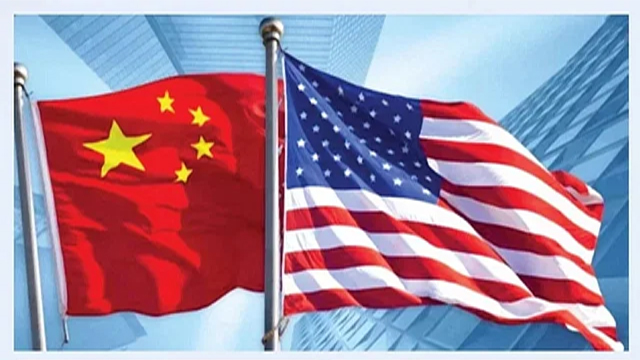
Implications of geo-economics on evolving global order
Published:
২৬ ডিসেম্বর ২০২৩, ১৯:০৪

The global arrangements are passing through an extraordinary period of political and economic turbulence. The disruptions caused by the Covid pandemic and then by the economic sanctions imposed on Russia by the West in the wake of the Russia-Ukraine war are well-known. Even before that, global tensions had been brewing with the US-initiated trade against China, with China contending to be another superpower challenging the US.
The term geo-economics may be taken to refer to the economic effect of many geographical factors like the location in a region of high or low economic growth, or in respect of its climate or access to sea, and so on, the impact of each of which on economic development is well researched.
Here, I shall rather define geo-economics from quite a different angle, that is, as the economic counterpart of what is known as geo-politics. In other words, we look at how the contests in global power politics are being played out by applying economic means of trade, investment, etc. and how it affects the rest of the global economy. And, by using the term “less developed countries”, I mainly refer to the numerous developing countries that are less advanced in relation to, say, the five existing BRICS countries.
Evolving trade arrangements and challenges in accessing trade preferences
In the past few decades since the mid-eighties, the trade negotiations under WTO were aimed at promoting economic globalisation, which had the potential of benefitting both the developed and the developing countries. Although the distribution of those benefits is alleged to have been tilted in favour of the developed countries, the rule-based arrangements had the advantage of not requiring negotiating skills on the part of individual countries, many of which in the developing world lack such skills.
There seems to be now very little chance of further progress in WTO negotiations; rather, the evolving global order is being shaped by the power struggle between the US and China, along with the formation of many regional partnerships that are aimed at promoting economic cooperation as well as addressing many divergent political and security concerns.
The scenario has become more complicated by the recent tilt towards nationalist trade policies in the industrialised countries, especially in the US, resulting mainly from of the resentment of the alleged impact of trade openness on labour displacement within those countries.
The rise of economic nationalism in the US in particular is reflected in its lack of enthusiasm even for any multilateral economic agreements. In 2017, Donald Trump withdrew from the TPP, the negotiations for which were initiated under the Obama administration in 2009 for a comprehensive trade agreement with several countries in the Asia-Pacific region with the declared objective of promoting US priorities and values.
The present Biden administration is showing only lukewarm response to the proposal for a much less comprehensive Asia-Pacific trade deal called Indo-Pacific Economic Framework (IPEF). Instead, American policy in Asia is now focused on limited bilateral deals that support President Biden's industrial policy, which seeks to boost domestic manufacturing. For example, Indonesia has initiated a trade deal with the US called “minerals for batteries” (Indonesia accounts for almost half the nickel that was mined globally last year).
And the government of the Philippines is pushing for a similar agreement. Very recently, the US has moved towards closer bilateral economic relations with Vietnam in an attempt to pull it away from strong economic links with China. At the same time as America is withdrawing from multilateral deals, China is throwing its hat into the ring.
The Regional Comprehensive Economic Partnership, a 14-member trade deal that came into effect last year under China’s initiative, will bind Asian economies more tightly to China. All this means that each developing countries is increasingly left to itself to negotiate and explore its global economic opportunities.
Even in the rule-based trade arrangements, there is need for individual countries, especially the less developed ones, to be careful in safeguarding their trade interests. In spite of its LDC status, Bangladesh was denied duty-free excess for of its main export item, namely, ready-made garments in the US market.
Following the Rana Plaza disaster in 2013, the US withdrew its GSP facility for exports from Bangladesh on ground of inadequate compliance of internally recognised worker rights. This was a noteworthy punitive measure on the part of the US, given that this facility of non-reciprocal duty-free access has been provided by the US since 1974 to a large number of developing countries, nearly 90 of them, in addition to the Least Developed Countries (LDCs).
At the time, this withdrawal of the GSP facility did not draw much attention, since it affected only some minor non-garment exports from Bangladesh (garment exports already being denied duty-free access) such as home textile, handicrafts, leather products, etc.; less noticed, however, was the potential negative impact of the measure on the future prospects of diversification of Bangladesh’s export in the US market.
The GSP was in fact first introduced by the EU in 1971, which was then followed by most industrialised economies as a policy of unilateral trade preferences to promote sustainable development in the developing world. The degree of trade preferences under the EU’s GSP varied according to the degree of beneficiary country’s level of development; compared to the general GSP, the LDCs were given the most generous preferences and there is a category in between called GSP+ given to the countries graduating from the LDC status or countries at similar level of development.
The eligibility for both the general GSP and GSP+ is contingent on implementation of the core human rights, labour standards, governance and other sustainable development conventions, which will be then reviewed periodically. Pakistan, for example, has recently qualified for GSP+ only after ratifying a number of international conventions. Clearly, for countries graduating from the LDC status, such as Bangladesh, it will be a challenge to meet these stringent criteria.
The impact of using economic tools in global power politics
The fallout of the West’s economic sanctions against Russia in the wake of the ongoing Ukraine-Russia war has been all too visible. It has demonstrated how much disruptive the impact of such use of economic tools in large-scale conflicts can be for the entire global economy. In the developing world, the poor people have been particularly hard hit by domestic inflation transmitted through the global price spikes especially in fuel prices. The lesson for these countries is to make contingency plans for meeting such global market crises such as by building adequate foreign reserves.
Compared to the immediate impact of the Russia-Ukraine war, that of the US-initiated trade war with China may be less visible, but has the potential to be far reaching and long-lasting for the entire global economy. The escalating confrontation, in the form of investment restrictions, export controls, and tariffs have direct short-run adverse effects on the exports and GDP of these two largest economies of the world; but other countries are hit indirectly through weaker demand for their own exports, either through supply chains or in response to weaker global economic growth.
It is noteworthy that, in spite of the trade war, the US and China remain the largest trading partners of each other. It is true that some developing countries may take advantage of the diversion of US trade and investment away from China, provided there is enough skills and favourable investment climate.
Vietnam, for example, seems to be in a better position in this respect than, say, Bangladesh. Studies show that in the wake of the US-China trade war that began in mid-2018, US imports from Vietnam increased sharply in respect of the Chinese goods that were targeted by higher US tariffs. Other South Asian countries also benefited to various extents by this trade diversion depending on the types of goods and their technology-intensity of production.
All this also show that the global economy is much more interdependent now than at the time of the Cold War, and that, in spite of the more complex geo-economics, there is now much more scope for the less developed countries to benefit from the global trade and supply chains through appropriate trade strategies.
The unfolding nature of the newly-formed 5-country group called BRICS (Brazil, Russia, India, China and South Africa) is another example of the complex interplay of geopolitics with geo-economic interests. Compared to G7 which is an exclusive club of the industrialised countries and G20 which is an extension of G7 where the emerging economies from the developing world meet the industrialised ones, BRICS has been formed to advance the cause of the Global South for a fairer and more representative global governance system.
China, has however an additional agenda, namely to use this platform to challenge the power of the US-led West – an agenda in which India, Brazil and South Africa have little interest. This tension within BRICS came to the surface in the last BRICS summit in 2003, where China was in favour of a large expansion of membership for what it called “like-minded” developing countries; but at the end, new membership was offered to only to five countries out twenty applicants. Bangladesh was one of the applicant countries which were denied membership.
China has other multilateral programmes aimed at enlisting the support of the “global south” to amplify Beijing’s voice on the world stage. Its so-called Belt and Road initiative is intended to be an economic tool to expand its sphere of influence among the developing countries. This represents China’s policy of “loans for votes”, that is, loans in exchange for UN votes in favour of China. The objective is two-fold: to ensure that a broad swath of the developing world remains open to Chinese trade and investment, and to use the voting power of developing countries at the UN and in other forums to project China as a global power.
With its huge accumulated funds from trade surpluses, China has the capability of using its largesse to purchase foreign policy favours. Indeed, countries with hefty debts to China, including Pakistan, Cambodia, Ethiopia, Sri Lanka, Zimbabwe and many others in Asia and Africa, have been found to align with China in voting in the UN General Assembly and in other UN specialised agencies. On the economic front, by 2023, China’s exports to US, EU and Japan combined have been exceeded by its exports to the Belt and Road Initiative countries.
*Wahiduddin Mahmud is an economist and former adviser to the caretaker government



Comment: